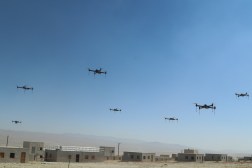The Pentagon should abandon Soviet-era centralized planning

Ukraine’s battlefield transformation shows how fast a military can adapt when it stops trying to predict the future. After less than two years at war, Ukraine ditched a clunky, centrally-planned acquisition system and replaced it with a weapon delivery pipeline driven by real-time operational feedback, commercial partnerships, and direct engagement with frontline operators. The Pentagon should follow suit.
The top-down requirements process Ukraine’s military inherited from Moscow in the 1990s kept headquarters analysts employed but left 87 percent of needs unfulfilled. Today, warfighters get the final say in what gets built. Drones that once relied on GPS and luck now use automated navigation and targeting algorithms to overcome operator error and Russian jamming, raising success rates from 20 percent to 70 percent. The newest generation uses fiber-optic cable for communication to eliminate the threat of electronic interference.
The Pentagon’s approach to weapon development looks more like the one used by Soviet apparatchiks. Requirements officers in the Joint Staff and military services try to guess capability gaps and potential solutions years in advance. By the time these analyses emerge from the Joint Capabilities Integration and Development System (JCIDS) two years later, the threat has changed, technology has marched on, and a different solution is likely needed.
By definition, predictive planning systems such as JCIDS cannot work in a dynamic environment. They define performance metrics before testing a single prototype because they assume cutting-edge defense systems can only arise from dedicated government-led research and development. That approach is now obsolete thanks to the rapid advance and broad availability of militarily-relevant commercial technology.
Ukraine’s successes show how the U.S. Department of Defense could unlock the potential of private-sector innovation through collaborative experimentation between engineers and operators. Instead of funneling their needs through a multi-year staffing process, Ukrainian commanders talk with local drone pilots and data scientists to identify problems and reach out to government offices that can pay for solutions.
Under Kyiv’s innovation model, a new uncrewed system concept can reach the battlefield in months, drawing on commercial AI to quickly adapt flight paths or identify targets in thousands of video streams. For example, a volunteer-driven missile team eschewed extensive predictive analysis and prototyped a new cruise missile in a year and a half — an unthinkable timeline under Ukraine’s previous Soviet-model bureaucracy.
Real-time operator feedback is essential to this approach. It defines what is “good enough” and helps program managers cut through the competing equities that often prevent a system from reaching the field. In less than a year, Ukraine’s military created Delta, a situational awareness system like the elusive Joint All-Domain Command and Control concept that the Pentagon has chased for nearly a decade. Coders started Delta with a single battlefield map and added new modules when soldiers asked for them. Now the system ties together thousands of drones, cameras, satellite feeds, and Western cannon and rocket artillery systems.
Instead of waiting for a glacial interagency process to dictate universal interoperability requirements, Delta’s developers iteratively add new elements and test them in the real fight. During NATO interoperability exercises in 2023, Delta proved the value of this bottom-up approach by sharing data via Link 16 with F-16 jets and integrating with Poland’s TOPAZ artillery fire control software. Delta reflects genuine cross-domain synergy, born out of emergent needs and continuous iteration, not years of staff approvals.
Ukraine’s success is not simply a fluke born out of existential desperation; it’s the logical consequence of removing unnecessary processes and letting warfighters shape the pipeline. While we in the United States prioritize box-checking staffing for documents that meet formatting guidelines and have all the right system views and appendices, Ukraine lets demand drive immediate action. This shift from central planning to distributed innovation has not only kept Ukraine in the fight but also opened the door to realizing advanced integrations like real-time targeting.
The Pentagon should take Ukraine’s combat lessons to heart and fund the work to find solutions for today’s problems. Requirements officers should stop trying to predict the future and begin collecting and refining operational challenges to drive experimentation. And acquisition executives should give innovative program managers and their industry partners the decision space to quickly develop systems that deliver relevant capability, use existing components, and can respond to future enemy countermeasures.
The DOD has experimented with new acquisition pathways and innovation initiatives that have these attributes. But “Band-Aid” solutions that speed up paperwork or create more prototypes don’t address the core problem: a requirements system that prioritizes predictive planning over operational results.
The Pentagon should retire centralized requirements processes such as JCIDS. In their place, the U.S. military services should fund focused campaigns of experimentation that test multiple solutions against clear operational problems, enable rapid learning from failure, and scale what actually works in realistic conditions. Until the DOD abandons its Soviet-style faith in headquarters apparatchiks and embraces structured experimentation driven by warfighters, it will continue to fall behind adversaries who are willing to adapt and learn.
Bryan Clark is a senior fellow and director of the Center for Defense Concepts and Technology at the Hudson Institute, and an expert in naval operations, electronic warfare, autonomous systems, military competitions and wargaming. Previously, he served as special assistant to the chief of naval operations and director of the CNO’s Commander’s Action Group, led studies on the Navy headquarters staff, and was an enlisted and officer submariner in the Navy.
Dan Patt is a senior fellow with the Hudson Institute’s Center for Defense Concepts and Technology, where he focuses on the role of information and innovation in national security. Patt also supports strategy at national security technology company STR and supports Thomas H. Lee Partners’ automation and technology investment practice. Previously, he co-founded and was CEO of Vecna Robotics and served as deputy director for the Defense Advanced Research Projects Agency’s (DARPA) Strategic Technology Office.






